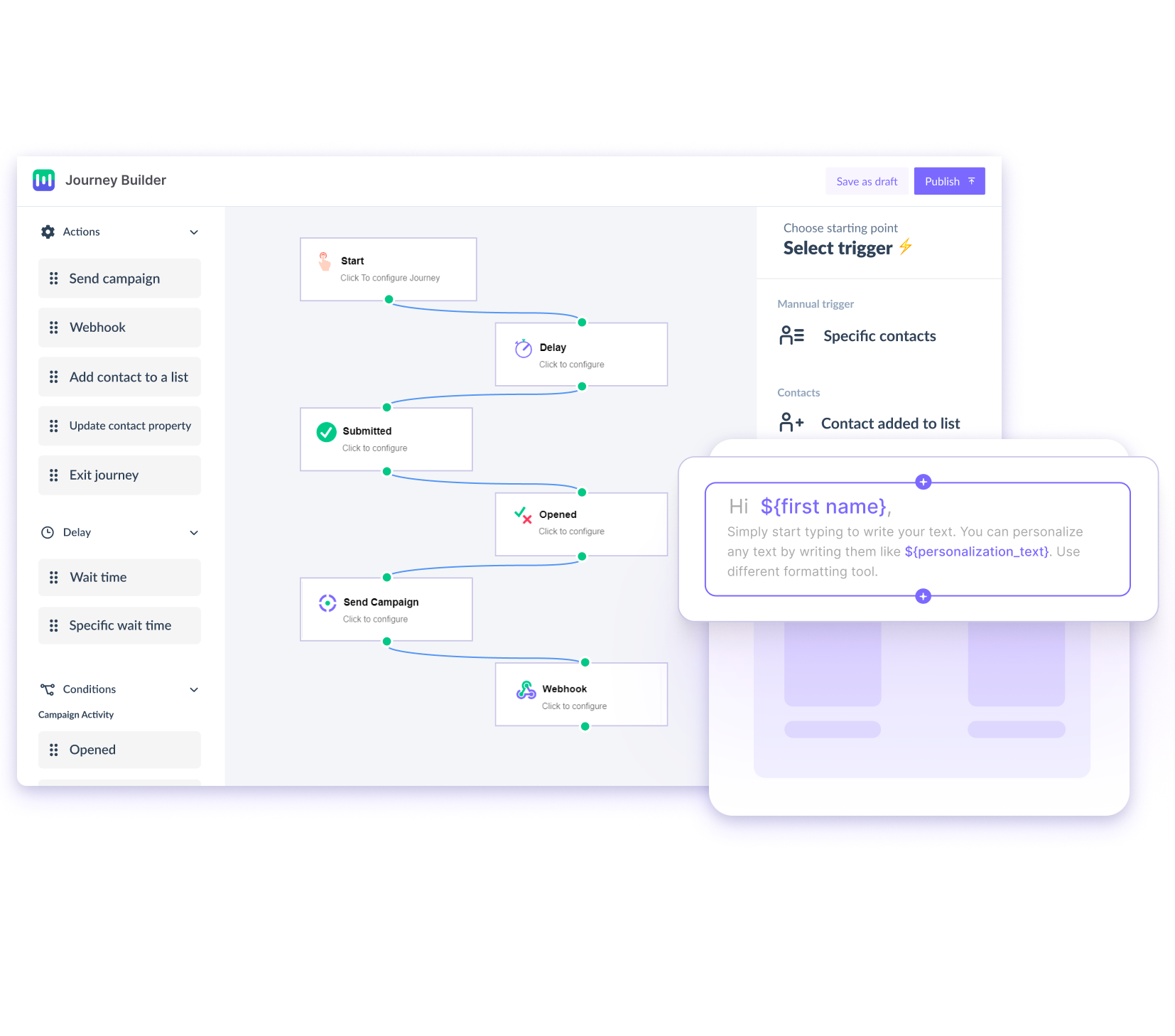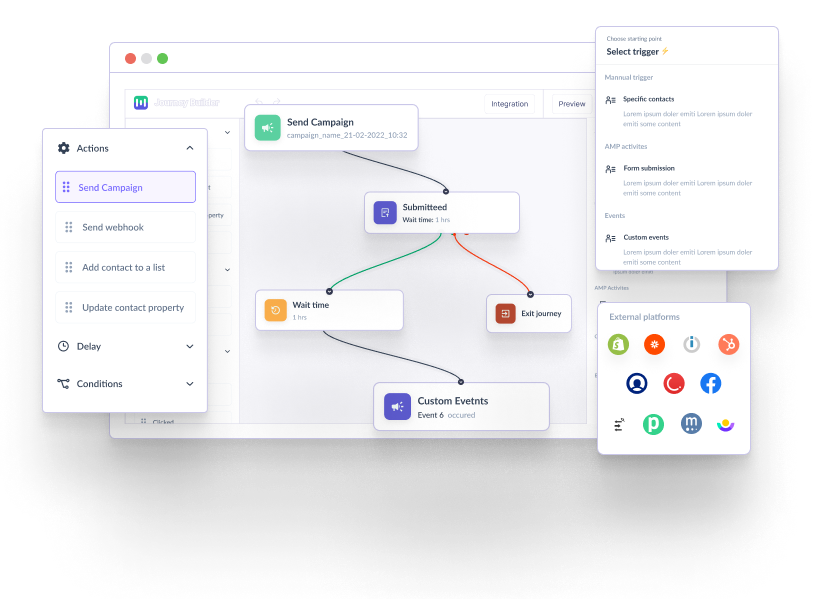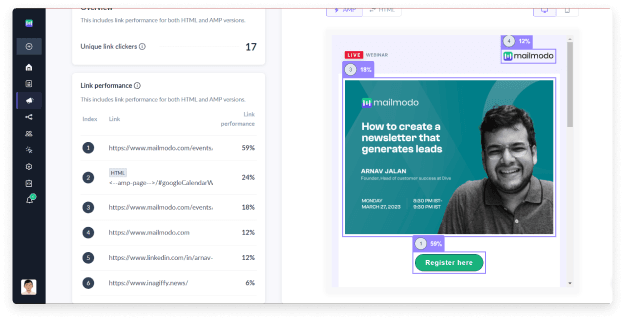What is B2B customer engagement?
B2B customer engagement refers to engaging your customers, who are businesses, with meaningful and value-driven interactions, throughout their lifecycle.
It involves delivering personalized solutions, and addressing the unique pain points of your B2B customers, so that they remain loyal to your business, which ultimately boosts your growth. Unlike B2C, B2B engagement focuses on long-term partnerships, leveraging channels like email marketing, webinars, account-based marketing, and in-depth consultations. This allows you to create a seamless and impactful experience that aligns with your B2B customers’ business goals.
Engagement goals for each stage of the lifecycle
You need to have an end goal in mind to better engage your customers and create your strategy. To create meaningful engagement, you need to focus on each stage of the B2B customer lifecycle. This includes 4 main stages—awareness, consideration, decision, and advocacy.
Let’s dive into these stages and explore the main goals behind engaging the B2B customer in each stage.

Awareness or discovery
The awareness stage is where B2B prospects begin to conduct research because they become aware of the challenges they face, and are looking for long-term solutions to mitigate these issues.
In this stage, your goal is to engage them in a way such that the end result is the onboarding of the business. To do this, you need to attract user attention by showing them the value you can provide and how this will benefit them in the long run.
Consideration
In the consideration stage, B2B prospects evaluate various solutions to determine the one that best fits their needs. At this stage, they want actionable insights, success stories, and solutions that directly address their pain points.
The goal in this stage is to nurture prospects and build their confidence in your offering. By demonstrating expertise and providing tailored content, you position yourself as not only the solution to their challenges but also a thought leader in the industry.
Decision
At the decision stage, prospects are ready to choose between competing solutions. They need reassurance that your offering delivers results and fits their specific requirements.
The goal here is to close the deal. Reduce friction, answer lingering questions, and highlight your value proposition in a way that makes the choice clear and easy.
Advocacy
The advocacy stage comes after a prospect has become a customer. It’s about ensuring they remain satisfied, engaged, and willing to promote your brand within their networks.
The goal is to transform satisfied customers into advocates who actively recommend your product or service within their professional networks, enhancing your reputation and driving new business opportunities.
How to engage your B2B customers
B2B customer engagement isn’t confined to a single channel or interaction; it’s an ecosystem of touchpoints that collectively shape the overall customer experience. There are multiple channels to reach your B2B customers, and within each of these channels, you can deploy different strategies to engage them.
Let’s take a look at each of these channels and the strategies you can use to ensure and increase B2B customer engagement.
Website
Your website is often the first point of contact for your prospects and acts as your digital storefront. To keep your customers engaged using your website, you can:
- Design a seamless user experience with clear navigation, fast load times, and mobile responsiveness.
- Provide valuable content on your website like case studies, whitepapers, and FAQs to establish authority.
- Use AI-driven chatbots or live chat to guide visitors in real-time, answering their questions and capturing leads.
- Implement account-based marketing (ABM) tactics by personalizing website content for returning users or key accounts.
- Leverage heatmaps and analytics to identify bottlenecks in the user journey and optimize accordingly.
- Have dedicated landing pages for important features and offerings and sign-up forms for collecting emails for future use.
Email marketing
Email marketing remains one of the most powerful tools for nurturing B2B relationships. Here’s how you can leverage email marketing as a channel to ensure B2B customer engagement:
- Create segmented campaigns tailored to industries, job roles, or engagement levels.
- Use triggered emails for key actions, like follow-ups after a webinar or reminders for incomplete demos.
- Create personalized reports and derive insights to improve engagement of different email marketing campaigns.
- A/B test subject lines, CTAs, and email formats to continuously refine your approach and increase engagement.
- Automate lifecycle emails to nurture leads across different stages while maintaining a personal touch.
- Use interactive emails to provide an app-like user experience within the emails.
-
Social media platforms like LinkedIn and Twitter are invaluable for B2B engagement. To make maximum use of social media for B2B customer engagement, you can:
- Share thought leadership content, like articles, infographics, and videos, to position your brand as an authority.
- Engage with prospects and customers through comments, polls, and direct messages.
- Leverage LinkedIn ads for targeted outreach, focusing on specific job titles or industries.
- Build community by hosting LinkedIn Live sessions or participating in relevant discussions.
- Use social listening tools to track brand mentions, industry trends, and competitor activities for actionable insights.
Customer support and success
Customer support isn’t just about solving problems—it’s a critical touchpoint for engagement and retention.
Here are some strategies to make use of this channel to maximize B2B customer engagement:
- Offer omnichannel support through live chat, email, and phone for convenience.
- Use customer success teams to proactively guide clients in achieving their goals with your product or service.
- Measure customer satisfaction with surveys and use the feedback to enhance your offerings.
- Implement a ticketing system with SLA tracking to ensure prompt and effective resolution of customer issues.
How to use Mailmodo to engage your B2B customers
Mailmodo is an all-in-one email marketing platform with unique capabilities that empower businesses to move beyond traditional marketing strategies, offering advanced solutions tailored to the nuances of B2B customer journeys.
Here’s how your brand or business can leverage Mailmodo to create an impactful B2B customer engagement strategy:
Interactive emails for enhanced engagement
Mailmodo offers interactive AMP emails that enable recipients to take actions directly within the email, reducing friction and enhancing engagement. This reduces drop-off rates and ensures seamless interactions, creating a more engaging and efficient communication flow. With these AMP-powered emails, you can allow prospects to book demos, respond to surveys, or complete forms directly within the email.
For example, a marketing agency can use Mailmodo to send an AMP email showcasing their services and enable prospects to schedule a consultation within the email itself.

Advanced dynamic segmentation and personalization
Personalization is key in B2B marketing, where each prospect’s needs and challenges differ. Mailmodo makes it easy to implement personalization beyond just first names. With Mailmodo, you can also undertake dynamic segmentation, which allows you to create segments that get updated in real time as and when a customer meets the criteria. This allows for personalization and fosters real-time relevance, ensuring that each email resonates with the recipient and drives higher engagement rates.
For example, a SaaS provider can send customized onboarding emails tailored to the unique goals of the clients.

Lifecycle automation for B2B buyer journeys
B2B customer journeys often involve multiple touchpoints and stakeholders. With Mailmodo, you can automate and streamline these journeys with precision. You can use the visual customer journey builder and set up automated campaigns for different stages of the customer lifecycle. Additionally, you can set up a series of emails that can be sent based on what action the recipient has performed. So it might send Email A if the recipient opened the previous email or Email B if the email was opened.
For instance, you can nurture leads with educational content during the awareness stage, send case studies during consideration, and provide onboarding materials post-purchase. Automation ensures consistent communication without manual intervention, keeping prospects engaged while freeing up time for your marketing team.

Advanced analytics for strategic decision-making
Understanding what works and what doesn’t is critical in refining your B2B engagement strategy. Mailmodo offers detailed analytics to track and measure campaign performance. You can monitor key metrics like open rates, click-through rates, and conversion rates for each campaign. You can also identify drop-off points and optimize content accordingly. This data-driven approach enables you to make informed decisions, ensuring that every campaign delivers maximum ROI.

Additional features
Mailmodo offers robust support especially when it comes to boosting email engagement with your B2B customers. You can use click maps to check which aspects of your emails receive the most attention, send time optimization to schedule emails to be sent at the optimal time based on each recipient’s behvior history and interactive widgets in your emails to allow recipients to interact with them and play games within the email. You can also use A/B testing to check which subject line or email copy resonates better with your customers and achieves more engagement.

Create and send interactive emails without coding in minutes
Takeaways
If there’s one thing clear from this article, it’s that delivering value-driven and personalized experiences is no longer optional—it’s a necessity, especially when you are looking to engage B2B customers.
By harnessing Mailmodo’s cutting-edge features, B2B marketers can craft a seamless engagement strategy that delivers value at every stage of the customer lifecycle. From interactive emails to data-driven automation, Mailmodo equips you with the tools you need to stay ahead in the ever-evolving world of B2B marketing.
















